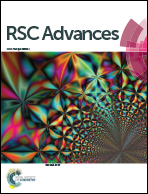The biogenic synthesis of a reduced graphene oxide–silver (RGO–Ag) nanocomposite and its dual applications as an antibacterial agent and cancer biomarker sensor†
Abstract
Cancer nanotechnology encourages cutting edge research utilizing nanomaterials for the diagnosis, therapy and prevention of cancer. Recognition of cancer-related biomarkers in the body has made early detection possible and thus, paves the way towards devising methods to control it from progressing to advanced stages. Hydrogen peroxide (H2O2) is a critical biomolecule, which plays an important dual role in cancer progression. Herein, we have developed a sensitive method for the detection of H2O2 utilizing a reduced graphene oxide–silver (RGO–Ag) nanocomposite. This RGO–Ag nanocomposite was prepared using a green and facile one-step synthesis approach utilizing the extract of a medicinal mushroom, Ganoderma lucidum. The higher content of polysaccharides in this extract makes it a potent reducing agent for the combined reduction of GO and AgNO3 to produce the RGO–Ag nanocomposite. The properties of the RGO–Ag obtained were characterized by UV-Vis spectroscopy, SEM, TEM, XRD, FT-IR and XPS techniques. The RGO–Ag modified electrode showed good electrocatalytic activity towards H2O2 when compared to other modified electrodes. Furthermore, it showed an LOD of 136 nM, which was determined using the LSV technique. The amperometric i–t curve displayed two different linear ranges of 1–100 μM and 100–1100 μM with an LOD of 3 and 56 nM, respectively. This excellent electrochemical performance towards H2O2 detection could contribute to advances in current cancer diagnosis. The RGO–Ag nanocomposite was also explored as a potential antibacterial agent. Owing to its synergistic effects, RGO–Ag showed a comparable antibacterial activity to the standard antibiotic, chloramphenicol. The combined antibacterial effects and sensing potential make this RGO–Ag nanocomposite a promising candidate for future health care.


 Please wait while we load your content...
Please wait while we load your content...